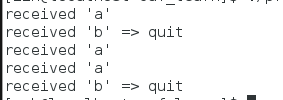e). 消息延迟发送(和前面没太大区别直接上代码)
#include <iostream> #include "caf/all.hpp" #include "caf/io/all.hpp" #include <string> #include <chrono> using namespace std; using namespace caf; behavior fun(event_based_actor* self){ return { [self](const string& str){ aout(self)<<str<<endl; auto t2 = std::chrono::system_clock::to_time_t(std::chrono::system_clock::now()); cout<<"dalay time :"<<t2<<endl; self->quit(); } }; } void fun1(event_based_actor* self, actor buddy){ self->delayed_send(buddy, std::chrono::seconds(1), "hi!"); } int main(){ auto actor1 = spawn(fun); auto t1 = std::chrono::system_clock::to_time_t(std::chrono::system_clock::now()); cout<<"before delayed_send :"<<t1<<endl; auto actor2 = spawn(fun1,actor1); caf::await_all_actors_done(); shutdown(); return 0; }
结果为

f). 消息前转(消息转发)forward.
贴上代码
#include <iostream> #include "caf/all.hpp" #include "caf/io/all.hpp" #include <string> #include <chrono> using namespace std; using namespace caf; behavior fun2(event_based_actor* self){ return { [self](const string& str){ aout(self)<<"C get message return to A"<<endl; aout(self)<<"C's address is :"<<self->address()<<endl; return "hello, A"; self->quit(); } }; } behavior fun1(event_based_actor* self, const actor &buddy){ return { [=](const string& str){ aout(self)<<"B get message forward to C"<<endl; self->forward_to(buddy); self->quit(); } }; } void fun(event_based_actor* self, const actor &buddy){ self->sync_send(buddy,"hi!").then( [=](const string& str) { aout(self)<<str<<endl; aout(self)<<"A think last_sender is :"<<self->last_sender()<<endl; } ); aout(self)<<"A send to B!"<<endl; } int main(){ auto actorC = spawn(fun2); auto actorB = spawn(fun1,actorC); auto actorA = spawn(fun,actorB); caf::await_all_actors_done(); shutdown(); return 0; }
结果为

使用了消息优先级,去caf代码里看了发现只有两种级别就是(hige 和normal)
 然后在用户手册上给出的示例代码是
然后在用户手册上给出的示例代码是
using a_atom = atom_constant<atom("a")>; using b_atom = atom_constant<atom("b")>; behavior testee(event_based_actor* self) { // send 'b' with normal priority self->send(self, b_atom::value); // send 'a' with high priority self->send(message_priority::high, self, a_atom::value); // terminate after receiving a 'b' return { [=](b_atom) { aout(self) << "received 'b' => quit" << endl; self->quit(); }, [=](a_atom) { aout(self) << "received 'a'" << endl; }, }; } int main() { // will print "received 'b' => quit" spawn(testee); await_all_actors_done(); // will print "received 'a'" and then "received 'b' => quit" spawn<priority_aware>(testee); await_all_actors_done(); shutdown(); }
结果是
 很好理解,因为第一个actor是不认识具有优先级的message的,只受到b消息,第二个就先收到a再收到b,这里有个细节就是当B本来因该是先收到的,但却变成了后收到,和发送的次序无关了。我甚至在两个发送语句之间加usleep(1000000) 都会先收到A后再输出B,这个Actor 感觉自己知道要收到priority 消息。
很好理解,因为第一个actor是不认识具有优先级的message的,只受到b消息,第二个就先收到a再收到b,这里有个细节就是当B本来因该是先收到的,但却变成了后收到,和发送的次序无关了。我甚至在两个发送语句之间加usleep(1000000) 都会先收到A后再输出B,这个Actor 感觉自己知道要收到priority 消息。
我还是不罢休,把代码改了改变成

结果为

我彻底服了CAF 太牛了把,当Actor不识别优先级时,它会把所有消息当成normal(正常的),当它知道时,就会把所有的优先级消息都接受完了再接受normal的。后来我改写了一些奇怪的语句,这CAF还是要我挺佩服得。
到这里消息都讲完了,之后开始CAF序列化之路。。。